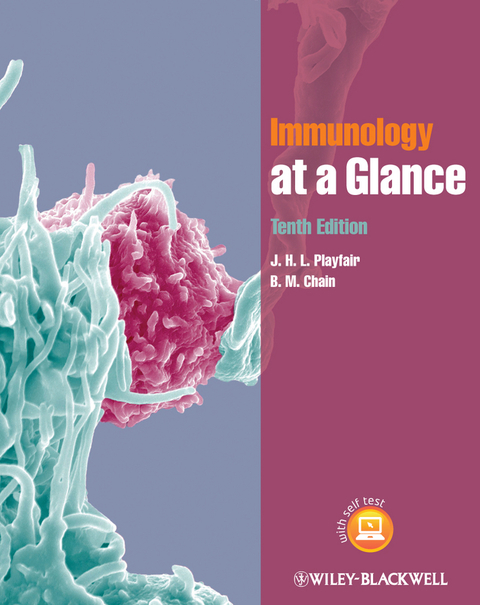Description
Efnisyfirlit
- Cover
- Companion Website
- Title
- Copyright
- Preface
- Acknowledgements
- Note on the Tenth Edition
- How to Use This Book
- Further Reading
- List of Abbreviations
- 1 The Scope of Immunology
- 2 Innate and Adaptive Immune Mechanisms
- Innate Immunity
- Adaptive Immunity
- Interactions between Innate and Adaptive Immunity
- 3 Recognition and Receptors: The Keys to Immunity
- Innate Immune System
- Cell-Associated Recognition
- Some Other Receptor Systems
- Adaptive Immune System
- 4 Cells Involved in Immunity: The Haemopoietic System
- A Note on Terminology
- 5 Receptors of the Innate Immune System
- 6 Complement
- Classic Pathway
- Alternative Pathway
- MBL and Other Pathways
- Lytic Pathway
- Complement Inhibitors
- 7 Acute Inflammation
- 8 Phagocytic Cells and the Reticuloendothelial System
- 9 Phagocytosis
- 10 Evolution of Recognition Molecules: The Immunoglobulin Superfamily
- 11 The Major Histocompatibility Complex
- 12 The T-Cell Receptor
- 13 Antibody Diversification and Synthesis
- 14 Antibody Structure and Function
- 15 Lymphocytes
- 16 Primary Lymphoid Organs and Lymphopoiesis
- Yolk Sac
- Bursa
- Liver
- Bone Marrow
- Thymus
- 17 Secondary Lymphoid Organs and Lymphocyte Traffic
- Lymph Node
- Spleen
- Mucosa-Associated Lymphoid Tissues
- 18 Antigen processing and presentation
- The Class I Pathway
- The Class II Pathway
- 19 The Antibody Response
- 20 Antigen – Antibody Interaction and Immune Complexes
- Antigen – Antibody Interaction
- Immune Complexes
- 21 Cell-Mediated Immune Responses
- 22 Tolerance
- 23 Cell Communication and Cytokines
- 24 The Cytokine Network
- 25 Immunity, Hormones and the Brain
- Central Nervous System
- Autonomic Nervous System
- Endocrine System
- Immune System
- Immunity and Psychological Illness
- 26 Antimicrobial Immunity: a General Scheme
- 27 Immunity to Viruses
- Viruses
- Atypical Organisms
- 28 HIV and AIDS
- 29 Immunity to Bacteria
- Bacteria
- 30 Immunity to Fungi and Ectoparasites
- Ectoparasites
- 31 Immunity to Protozoa
- 32 Immunity to Worms
- Roundworms (Nematodes)
- Flukes (Trematodes)
- Tapeworms (Cestodes)
- 33 Immunodeficiency
- Defects Affecting Several Types of Cell
- Defects Predominantly Affecting T Cells
- Defects Predominantly Affecting B Cells
- Defects of Complement
- Defects Affecting Myeloid Cells
- Receptors of Innate Immunity
- Secondary Immunodeficiency
- 34 Harmful Immunity: a General Scheme
- Innate Immune Damage
- Types of Hypersensitivity (Gell and Coombs’ Classification)
- 35 Allergy and Anaphylaxis
- Mediators
- Inhibitors
- Non-IgE Triggering
- Allergic Diseases
- 36 Immune Complexes, Complement and Disease
- Immune Complex Diseases
- Haemolytic Disease of the Newborn
- 37 Chronic and cell-mediated inflammation
- Granulomas
- Granulomatous Diseases
- 38 Autoimmune Disease
- Self-Tolerance and Self-Reactivity
- Autoimmune Diseases
- Treatment of Autoimmunity
- 39 Transplant Rejection
- Typing and Matching
- Rejection
- Immunosuppression
- 40 Immunosuppression
- Non-specific Immunosuppression
- Specific Immunosuppression
- 41 Immunostimulation and Vaccination
- Passive Immunization
- Active Immunization (‘vaccination’)
- 42 Cancer Immunology
- Non-Specific Immunotherapy
- Specific Immunotherapy
- 43 Immunity and Clinical Medicine
- 44 Investigating Immunity
- Investigating Immunodeficiency
- Investigating Allergy
- Investigating Autoimmunity
- Tissue Typing and Transplantation
- Tumours of Immunological Cells
- 45 Immunology in the Laboratory
- 46 Out of the Past: Evolution of Immune Mechanisms
- Unicellular Organisms
- Invertebrates
- Vertebrates
- Plants
- 47 Into the future: immunology in the age of genomics
- Self-Assessment Questions
- Answers
- Appendix I: Comparative Sizes
- Comparative Molecular Weights
- Appendix II: Landmarks in the History of Immunology
- Some Unsolved Problems
- Appendix III: CD Classification
- Index
- End User License Agreement





